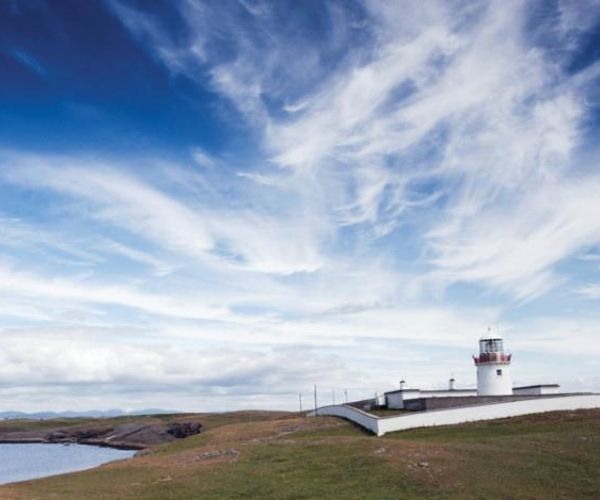If you want to visit Ireland in 2021 and stay somewhere flashy with a difference, how about a lighthouse on Ireland’s coastline?
Whether they are functioning towers or historic landmarks, lighthouses are full of intrigue. Their isolated locations, vantage points over cliffs and oceans, and associations with stories of storms and shipwrecks — whatever the reason, they capture the imagination.
We arrange overnight stays in these historic lighthouses, which are set in some of the most remote parts of Europe with spectacular views across the ocean. They are found along the beautiful Wild Atlantic Way, Northern Causeway Coast, and Ireland’s Ancient East and from secure, simple lodgings which will give you an insight into how lightkeepers lived generations ago to ultimate luxury with light-filled modern rooms.
To rest your head in one of Ireland’s lighthouses is truly an unforgettable experience.
Galley Head, Cork
The gleaming white lighthouse of Galley Head was the most powerful lighthouse in the world when at the time of its construction in 1875. Lightkeepers stationed here would have seen history unfolding before their eyes, witnessing the sinking of the Lusitania after it was torpedoed off the Old Head of Kinsale in 1915 and sighting many military vessels during the first and second World Wars. Galley Head Lighthouse is a major shore light on the south coast – along with the Old Head of Kinsale and Fastnet lighthouses, Galley Head is an important aid to offshore navigation.
It is perched at the southernmost point of a picturesque headland known as Dundeady Island and is close to the charming market town of Clonakilty – home of the famous black pudding!
Wicklow Head, Wicklow
Built in 1781 and with a staggering 109 steps leading to the kitchen for unbeatable views of the Irish Sea, Wicklow Head Lighthouse is a special place to stay on Ireland’s east coast. The light itself was converted to automatic operation in 1994, but the lighthouse’s original light source was 20 animal fat candles set against a large mirror.
Twin lighthouses were originally built to prevent mariners from confusing Wicklow Head (the name “Wicklow” comes from the Viking word “Wykylo” or “Viking’s Loch”) with the single lights of Howth Head, north of Dublin, and Hook Head in Wexford.
There are six octagonal rooms, some with metre-deep window seats for soaking up the sunshine and the views.
St John’s Point, Down
With vibrant yellow and black stripes covering its exterior and reaching a height of 40m, St John’s Point Lighthouse in Killough, Co Down, is hard to miss. It was built in 1844 and enjoys an interesting history – Brendan Behan’s father is said to have been contracted to paint it in 1950 and he reportedly enlisted the help of Brendan himself, according to GreatLighthouses.com.
The ill-fated RMS Titanic did initial trials in the waters around this lighthouse and Van Morrison fans might recognise its name from his song Coney Island.
Enjoy this beautiful location from one of the two restored lightkeepers’ cottages.
Blackhead, Antrim
Blackhead Lighthouse looks over the sea from the edge of a majestic cliff on Belfast Lough. It was built and showed its first light in 1902. It would have guided many famous vessels during Belfast’s golden age of shipping, including the ill-fated Titanic.
Lightkeepers lived at the station until 1975 and you can stay in one of three restored lightkeepers’ houses right beside the lighthouse, which are full of character and comfort, with antique furniture and seafaring curios true to its maritime past.
From this truly unique setting, watch glorious sunsets and wake up to gorgeous sunrises. Be calm and content by the sea and by the sure, steady flash of the lighthouse beam.
Loop Head, Clare
Loop Head Lighthouse is perched at the end of the Loop Head Peninsula in beautiful West Clare. There has been a lighthouse here since 1670. Back then, it was a coal-burning brazier on a platform on the roof of the cottage lighthouse where the lightkeeper lived. You can still see part of the old cottage on the site. The first ‘tower’ lighthouse was built in 1802 and replaced with a new tower in 1854.
With fine weather, you will enjoy views south as far as the Blasket Islands and north to the Twelve Pins in Connemara, along the wild Atlantic Way. It’s also the perfect place to spot whales, dolphins and seals from, while the rock ledges and caves of the dramatic cliffs are home to many seabirds. Close to The Burren and Cliffs of Moher, this lighthouse attracts geologists from around the world. The area attracts geologists from all over the world.
Crookhaven Lighthouse, Cork
Crookhaven Lighthouse dates from 1843 and is surrounded by the original dwellings formerly occupied by the keepers of Fastnet Lighthouse, Mizen fog station and Crookhaven Lighthouse. It is located at Ireland’s most southwesterly harbour and village.
Nestled alongside the lighthouse is the cottage built for the Crookhaven lighthouse keepers. The original cottage dates from 1843 and a luxury, modern re-design gives guests spectacular light-filled views across the underdeveloped coastline and the hypnotic blue waves of the Atlantic Ocean.
St John’s Point, Donegal
Miles from anywhere, a stay at St John’s Point Lighthouse offers a one-of-a-kind getaway. With two lightkeepers’ cottages, it is set on one of the longest peninsulas in the country, looking towards Mullaghmore (which “Normal People” fans will know!), the coast of County Sligo and out into the North Atlantic.
The lighthouse exhibited its first light in November 1831, almost 250 years after the Spanish Armada ships sent by Philip II of Spain to invade England were washed up on Irish shores after violent storms. Three huge ships which were wrecked on nearby Streedagh Strand.
It is one of 70 lighthouses operated by the Commissioners of Irish Lights around the coast of Ireland and continues to provide a vital role in maritime safety today.
Fanad Head, Donegal
Featuring panoramic views of Lough Swilley and the wild Atlantic Ocean, Fanad Head lighthouse is located on its own little promontory.
Following the shipwreck of the HMS Saldanha – of which the only survivor was the vessel’s parrot – in Lough Swilly in 1812, a lighthouse was proposed for Fanad Head. The structure was designed by one of the most prominent civil engineers of the time, George Halpin, and first lit on March 17, 1817 (what a place to celebrate St Patrick’s Day!).
Located in the Donegal Gaeltacht, the area is rich in history but it is one of the few places on earth where you can find this special sense of solitude. Stay in one of the lighthouse cottages to savour the uninterrupted views of the land and sea that stretch for miles.






















